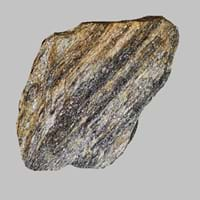Definition
Limestone is a sedimentary rock composed mostly of calcite and aragonite, which are different crystal forms of calcium carbonate
Mylonite is a metamorphic rock formed by ductile deformation during intense shearing encountered during folding and faulting, a process termed cataclastic or dynamic metamorphism
Origin
New Zealand
New Zealand
Discoverer
Belsazar Hacquet
Unknown
Etymology
From lime and stone in late 14th Century
From Greek mulōn mill + -ite
Class
Sedimentary Rocks
Metamorphic Rocks
Sub-Class
Durable Rock, Medium Hardness Rock
Durable Rock, Medium Hardness Rock
Group
Not Applicable
Not Applicable
Other Categories
Fine Grained Rock, Opaque Rock
Fine Grained Rock, Opaque Rock
Texture
Clastic or Non-Clastic
Foliated
Color
Beige, Black, Blue, Brown, Cream, Gold, Green, Grey, Light Green, Light Grey, Linen, Pink, Red, Rust, Silver, White, Yellow
Black to Grey
Durability
Durable
Durable
Scratch Resistant
Yes
Yes
Appearance
Rough and Banded
Dull, Banded and Foilated
Interior Uses
Decorative Aggregates, Interior Decoration
Decorative Aggregates, Interior Decoration
Exterior Uses
As Building Stone, As Facing Stone, Garden Decoration, Office Buildings
As Building Stone, As Facing Stone, Paving Stone, Garden Decoration
Other Architectural Uses
Curbing
Curbing
Construction Industry
Cement Manufacture, Cobblestones, for Road Aggregate, Production of Glass and Ceramics, Raw material for the manufacture of mortar, Roadstone, Source of calcium
for Road Aggregate, Landscaping, Roadstone
Medical Industry
In Chemical and Pharmaceutical Industry, Medicines and Cosmetics
Not Yet Used
Antiquity Uses
Artifacts, Monuments, Sculpture, Small Figurines
Artifacts, Monuments
Commercial Uses
Animal feed filler, As a Feed Additive for Livestock, Paper Industry, Raw material for manufacture of quicklime, slaked lime, Soil Conditioner, Used in aquariums, Whiting material in toothpaste, paint and paper
Creating Artwork, Gemstone, Jewelry
Types
Chalk, Coquina, Fossiliferous Limestone, Lithographic Limestone, Oolitic Limestone, Travertine, Tufa
Blastomylonites, Ultramylonites and Phyllonites
Features
Host Rock for Lead, Stalactites and stalagmites are formed from this rock, Zinc and Copper Deposits
Surfaces are often shiny
Archaeological Significance
Famous Monuments
Acropolis of Athens in Greece, Agia Sophia in Istanbul, Turkey, Al Aqsa Mosque in Jerusalem, Angkor Wat in Cambodia, Big Ben in London, Charminar in Hyderabad, India, Chhatrapati Shivaji Terminus in Maharashtra, India, Chichen Itza in Mexico, Empire State Building in New York, Khajuraho Temples, India, Kremlin in Moscow, Louvre in Paris, France, Neuschwanstein in Bavaria, Potala Palace in Lahasa, Tibet, Wailing Wall in Jerusalem
Data Not Available
Famous Sculptures
Ajanta Caves in Maharashtra, India, Elephanta Caves in Maharashtra, India
Data Not Available
Formation
Limestone is a sedimentary rock which is mainly made up of calcium carbonate.
Mylonites are ductilely deformed rocks formed by the accumulation of large shear strain, in ductile fault zones.
Mineral Content
Calcite, Chert, Clay, Dolomite, Quartz, Sand, Silt
Porphyroblasts
Compound Content
Aluminium Oxide, NaCl, CaO, Iron(III) Oxide, FeO, MgO
Aluminium Oxide, Calcium Sulfate, Chromium(III) Oxide, Iron(III) Oxide, Magnesium Carbonate, Silicon Dioxide
Types of Metamorphism
Not Applicable
Not Applicable
Types of Weathering
Biological Weathering, Chemical Weathering, Mechanical Weathering
Biological Weathering, Chemical Weathering, Mechanical Weathering
Types of Erosion
Chemical Erosion, Coastal Erosion
Chemical Erosion, Sea Erosion, Wind Erosion
Grain Size
Fine Grained
Fine Grained
Fracture
Splintery
Conchoidal
Porosity
Less Porous
Highly Porous
Luster
Dull to Pearly
Shiny
Cleavage
Non-Existent
Conchoidal
Toughness
1
Not Available
Specific Gravity
2.3-2.7
2.97-3.05
Transparency
Opaque
Opaque
Density
2.3-2.7 g/cm3
2.6-4.8 g/cm3
Resistance
Pressure Resistant
Heat Resistant, Impact Resistant, Pressure Resistant
Deposits in Eastern Continents
Asia
Brunei, India, Indonesia, Malaysia, Singapore, Thailand, Vietnam
China, India, Indonesia, Saudi Arabia, South Korea
Africa
Cameroon, Chad, Ghana, Kenya, Malawi, Sudan, Tanzania, Togo, Zambia, Zimbabwe
Eritrea, Ethiopia, Ghana, South Africa, Western Africa
Europe
United Kingdom
England, Finland, France, Germany, Great Britain, Greece, United Kingdom
Others
Not Yet Found
Not Yet Found
Deposits in Western Continents
South America
Colombia
Not Yet Found
Deposits in Oceania Continent
Australia
Adelaide, New Zealand, Queensland, Tonga, Victoria, Yorke Peninsula
Central Australia, Western Australia
All about Limestone and Mylonite Properties
Know all about Limestone and Mylonite properties here. All properties of rocks are important as they define the type of rock and its application. Limestone belongs to Sedimentary Rocks while Mylonite belongs to Metamorphic Rocks.Texture of Limestone is Clastic or Non-Clastic whereas that of Mylonite is Foliated. Limestone appears Rough and Banded and Mylonite appears Dull, Banded and Foilated. The luster of Limestone is dull to pearly while that of Mylonite is shiny. Limestone is available in beige, black, blue, brown, cream, gold, green, grey, light green, light grey, linen, pink, red, rust, silver, white, yellow colors whereas Mylonite is available in black to grey colors. The commercial uses of Limestone are animal feed filler, as a feed additive for livestock, paper industry, raw material for manufacture of quicklime, slaked lime, soil conditioner, used in aquariums, whiting material in toothpaste, paint and paper and that of Mylonite are creating artwork, gemstone, jewelry.









